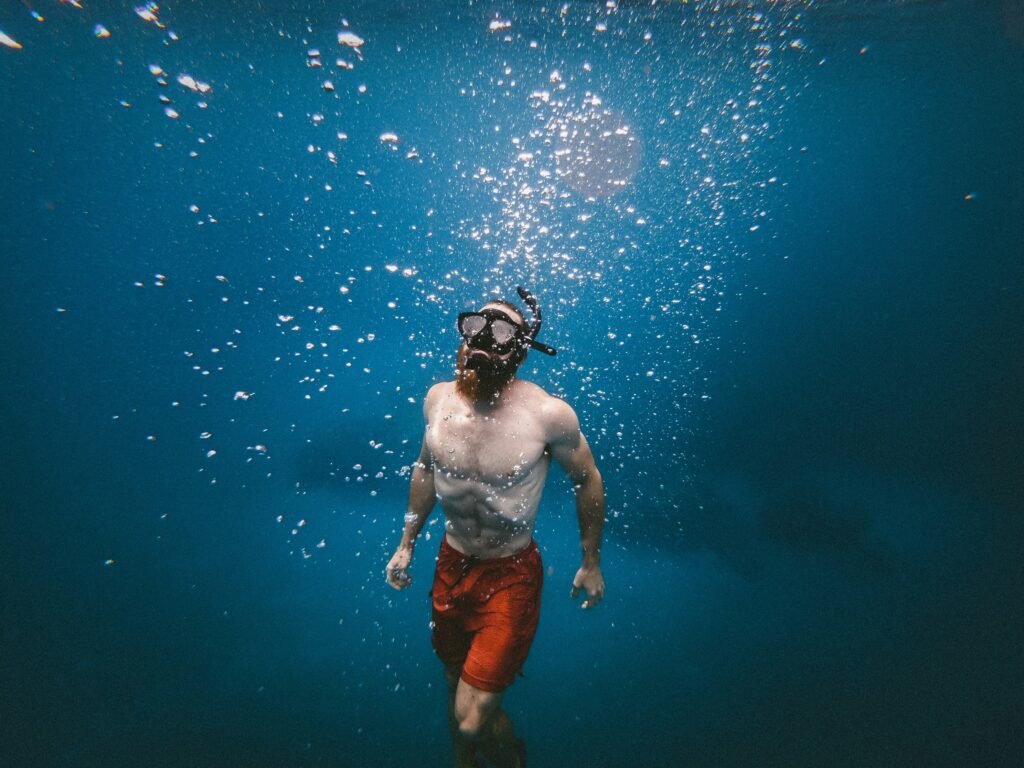

The Red Sea is a paradise for diving and snorkeling enthusiasts. Its warm, crystal-clear waters are home to vibrant coral reefs and a diverse array of marine life. Colorful fish, graceful sea turtles, and even friendly dolphins can be spotted in these waters. The visibility is excellent, often reaching up to 40 meters, making it easy to see the underwater wonders.
Beginners and experienced divers alike can enjoy the many dive sites, ranging from shallow reefs to deep shipwrecks. Snorkelers can also have a great time exploring the underwater world from the surface. With year-round warm temperatures and calm seas, the Red Sea offers perfect conditions for water activities.
Whether you’re interested in seeing exotic fish, exploring coral gardens, or simply enjoying the beauty of the underwater world, diving and snorkeling in the Red Sea is an unforgettable experience.
1. Introduction to the Red Sea
1.1. Geographical location and unique features
The Red Sea, nestled between Africa and Asia, is a remarkable body of water known for its exceptional marine life and crystal-clear waters. Stretching over 2,250 kilometers in length and reaching depths of up to 3,040 meters, this narrow sea offers a diverse range of underwater environments.
One of the Red Sea’s most distinctive features is its high salinity, which contributes to the vibrant colors of its coral reefs and the unique adaptations of its marine inhabitants. The sea’s isolation and stable environmental conditions have allowed for the evolution of many endemic species, making it a truly special destination for diving and snorkeling enthusiasts.
1.2. Marine biodiversity and ecosystems
The Red Sea boasts an incredible array of marine life, with over 1,200 species of fish and 250 species of coral. Its ecosystems range from shallow seagrass beds to deep-water reefs, providing habitats for a wide variety of creatures.
The coral reefs of the Red Sea are particularly noteworthy, as they are among the most resilient in the world. These reefs have adapted to withstand higher temperatures and salinity levels, making them potential refuges for coral species threatened by climate change in other parts of the world.
1.3. Historical and cultural significance
The Red Sea has played a crucial role in human history for thousands of years. Ancient Egyptians, Greeks, and Romans all utilized its waters for trade and exploration. The sea is mentioned in various religious texts and has been the site of numerous significant historical events.
Today, the Red Sea continues to be an important cultural and economic hub, with coastal communities relying on fishing, tourism, and maritime trade for their livelihoods. This rich history and cultural significance add an extra layer of interest to any diving or snorkeling adventure in the region.
2. Planning Your Red Sea Adventure
2.1. Best times to visit for diving and snorkeling
The Red Sea offers year-round opportunities for diving and snorkeling, but certain seasons may be more suitable depending on your preferences:
- Spring (March to May): Mild temperatures and good visibility make this an excellent time for diving and snorkeling.
- Summer (June to August): Water temperatures are at their warmest, but surface conditions can be hot and humid.
- Autumn (September to November): Another ideal period with comfortable temperatures and good visibility.
- Winter (December to February): Cooler air temperatures but still suitable for diving. Some sites may experience rougher sea conditions.
2.2. Popular destinations and dive sites
The Red Sea offers numerous world-class diving and snorkeling destinations:
- Sharm El Sheikh, Egypt: Known for its vibrant coral reefs and diverse marine life.
- Hurghada, Egypt: Offers a mix of shallow and deep dive sites suitable for all experience levels.
- Dahab, Egypt: Famous for the Blue Hole and other technical dive sites.
- Aqaba, Jordan: Features well-preserved coral reefs and historical wrecks.
- Marsa Alam, Egypt: Known for encounters with dugongs and other large marine animals.
2.3. Travel arrangements and accommodations
When planning your Red Sea adventure, consider the following:
- Flights: Major airports serving the Red Sea include Sharm El Sheikh International Airport, Hurghada International Airport, and King Hussein International Airport in Aqaba.
- Accommodations: Options range from budget-friendly hostels to luxury resorts. Many hotels offer dive packages and have on-site dive centers.
- Liveaboards: For serious divers, liveaboard trips provide access to more remote dive sites and the opportunity for multiple dives per day.
3. Diving in the Red Sea
3.1. Types of dive experiences available
The Red Sea offers a diverse range of diving experiences to suit all levels:
- Reef diving: Explore vibrant coral gardens teeming with colorful fish.
- Wreck diving: Discover historical shipwrecks like the SS Thistlegorm or the Salem Express.
- Wall diving: Experience dramatic drop-offs along the Red Sea’s deep trenches.
- Night diving: Witness the nocturnal activities of marine life on the reef.
- Technical diving: For advanced divers, sites like the Blue Hole offer challenging deep dives.
3.2. Essential gear and equipment
While most dive centers provide rental equipment, here’s a list of essential gear for diving in the Red Sea:
- Mask, fins, and snorkel
- Wetsuit (3-5mm depending on the season)
- Dive computer
- Underwater camera (optional, but highly recommended)
3.3. Safety measures and certifications
Safety should always be a top priority when diving. Here are some important considerations:
- Ensure you have appropriate dive insurance coverage.
- Always dive within your certification limits and experience level.
- Follow local regulations and dive site guidelines.
- Use reputable dive operators with qualified instructors.
- Consider taking a refresher course if you haven’t dived recently.
4. Snorkeling Opportunities
4.1. Top snorkeling spots in the Red Sea
The Red Sea offers excellent snorkeling opportunities, even for those who prefer to stay close to the surface:
- Ras Mohammed National Park, Egypt: Shallow reefs teeming with marine life.
- Giftun Islands, Hurghada: Crystal-clear waters and vibrant coral gardens.
- Aqaba Marine Park, Jordan: Protected area with well-preserved coral reefs.
- Dolphin House, Marsa Alam: Opportunity to snorkel with wild spinner dolphins.
4.2. Necessary equipment for snorkeling
Basic snorkeling gear includes:
- Mask and snorkel
- Fins
- Rash guard or wetsuit for sun protection
- Reef-safe sunscreen
4.3. Tips for beginners and families
- Start in shallow, calm waters to build confidence.
- Practice using your equipment in a pool before heading to the open water.
- Always snorkel with a buddy and stay within sight of the shore or boat.
- Be aware of currents and weather conditions.
- Avoid touching or standing on coral to protect the delicate ecosystem.
5. Marine Life Encounters
5.1. Coral reefs and their inhabitants
The Red Sea’s coral reefs are home to a diverse array of marine life:
- Hard and soft corals in various shapes and colors
- Reef fish such as clownfish, parrotfish, and butterflyfish
- Moray eels and octopuses hiding in crevices
- Sea turtles grazing on seagrass beds
5.2. Pelagic species and seasonal visitors
In addition to reef inhabitants, the Red Sea attracts larger pelagic species:
- Whale sharks (seasonal, typically from May to July)
- Manta rays and various other ray species
- Dolphins, including spinner and bottlenose varieties
- Hammerhead sharks (in certain areas and seasons)
5.3. Rare and endangered species
The Red Sea is home to several rare and endangered species:
- Dugongs, often spotted in seagrass areas
- Various species of sea turtles, including hawksbill and green turtles
- Red Sea clownfish, an endemic species
- Oceanic whitetip sharks, now rare due to overfishing
6. Environmental Conservation
6.1. Threats to the Red Sea ecosystem
Despite its resilience, the Red Sea ecosystem faces several threats:
- Climate change and coral bleaching
- Coastal development and habitat destruction
- Overfishing and illegal fishing practices
- Plastic pollution and marine debris
6.2. Sustainable tourism practices
As visitors, we can help protect the Red Sea by:
- Choosing eco-friendly tour operators and accommodations
- Using reef-safe sunscreen and avoiding single-use plastics
- Practicing responsible diving and snorkeling techniques
- Supporting local conservation initiatives
6.3. Conservation efforts and how to contribute
Several organizations are working to protect the Red Sea’s marine environment:
- Red Sea Environmental Centre (RSEC)
- Hurghada Environmental Protection and Conservation Association (HEPCA)
- Royal Marine Conservation Society of Jordan (JREDS)
Visitors can contribute by volunteering, participating in beach clean-ups, or making donations to these organizations.
7. Cultural Experiences and Land-Based Activities
7.1. Exploring coastal towns and villages
The Red Sea coast offers a rich cultural tapestry:
- Explore the markets and cafes of Dahab, Egypt
- Visit the historic port city of Jeddah, Saudi Arabia
- Experience the laid-back atmosphere of Aqaba, Jordan
7.2. Historical sites and attractions
The region is steeped in history:
- Visit the ancient Egyptian port of Berenice
- Explore the Ottoman-era Aqaba Fort
- Take a day trip to Petra from Aqaba
7.3. Local cuisine and traditions
Sample the flavors of the Red Sea region:
- Try fresh seafood at local restaurants
- Experience a traditional Bedouin dinner in the desert
- Enjoy Arabic coffee and dates as a gesture of hospitality
Summary :Diving and Snorkeling in the Red Sea
The Red Sea offers an unparalleled underwater experience, combining vibrant marine life with rich cultural heritage. From world-class diving and snorkeling to exploring ancient historical sites, the region provides a diverse range of activities for all types of travelers. By practicing responsible tourism and supporting conservation efforts, we can help preserve this unique ecosystem for future generations to enjoy.
Frequently Asked Questions and answers (FAQs)
- Q: Do I need a visa to visit Red Sea destinations?A: Visa requirements vary depending on your nationality and the specific country you’re visiting. Check with the relevant embassy or consulate before traveling.
- Q: Is it safe to dive in the Red Sea?A: Yes, when proper safety measures are followed and you dive with reputable operators. Always ensure you’re diving within your certification limits.
- Q: What’s the best time of year to see whale sharks in the Red Sea?A: Whale sharks are typically spotted between May and July, particularly around Sharm El Sheikh and Marsa Alam.
- Q: Can I snorkel if I’m not a strong swimmer?A: Yes, many snorkeling spots have calm, shallow waters suitable for beginners. Always use a life jacket if you’re not confident in your swimming abilities.
- Q: How can I minimize my environmental impact while visiting the Red Sea?A: Use reef-safe sunscreen, avoid touching coral, properly dispose of waste, and choose eco-friendly tour operators and accommodations.
